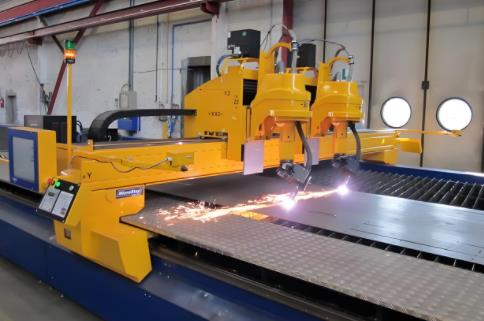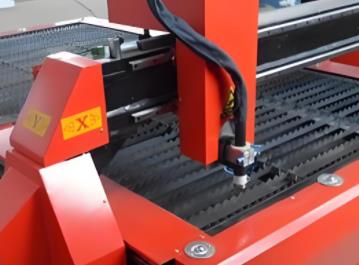In the fast-paced world of industrial manufacturing, the CNC plasma cutting machine stands out as a game-changer for metal fabrication. Whether you're a seasoned professional or new to the field, this guide dives deep into what a CNC plasma cutter is, how it operates, and why it's essential for industries like automotive, shipbuilding, and construction. By combining computer numerical control (CNC) with plasma arc technology, these machines deliver precision, speed, and affordability in cutting conductive metals. In this comprehensive overview, we'll cover everything from the core components and evolution to practical applications and FAQs, ensuring you gain actionable insights to optimize your operations.
What Is a CNC Plasma Cutting Machine?
A CNC plasma cutting machine is an automated tool that uses a superheated plasma arc—generated by ionizing gases like air or nitrogen—to slice through electrically conductive materials such as steel, aluminum, and stainless steel. Unlike manual cutters, it relies on pre-programmed G-code to control torch movement along multiple axes, ensuring repeatable, high-accuracy cuts without human intervention. This makes it ideal for tasks requiring consistency, like producing complex parts for automotive frames or ship hulls.
Key Features and How It Compares to Other Tools
To avoid confusion, here's how CNC plasma cutters differ from alternatives like laser or waterjet machines:
- Material Focus: Excels at conductive metals (e.g., up to 150mm thick steel), whereas lasers suit thinner materials, and waterjets handle non-conductive items.
- Speed and Cost: Plasma cutting is faster for thick metals (1–5 m/min) and more affordable than lasers or waterjets, with industrial models ranging from $30,000 to $200,000.
- Precision: Offers tolerances as tight as ±0.1mm, outperforming manual methods in repeatability.
For a deeper dive into how plasma cutting stacks up, check out this comparison table from Hypertherm, a leader in cutting technology.
How Does a CNC Plasma Cutter Work?
Understanding the operation of a CNC plasma cutting machine involves breaking down its workflow and underlying principles. Here's a step-by-step breakdown:
- Design and G-Code Input: Operators create a digital design in CAD software (e.g., Fusion 360), which is converted into G-code commands for the CNC controller.
- Machine Setup: The metal material is secured on the worktable, and parameters like gas type and cutting speed are set.
- Plasma Arc Initiation: The machine ionizes gas into a plasma jet at 20,000–50,000°C, using an electric arc between the electrode and nozzle.
- Automated Cutting: Servo motors move the torch along X/Y/Z axes, melting the metal while compressed gas blows away molten debris.
- Post-Processing: The cut part is removed, and any residual dross is cleaned off.
This process relies on scientific principles like ionization (creating plasma from gas), arc compression (for narrow, precise cuts), and heat transfer (melting metal efficiently). For example, the plasma arc's intense heat quickly liquefies thick steel, making it perfect for high-volume projects.

Key Components of a CNC Plasma Cutting Machine
A CNC plasma cutting machine is built from modular components that work in harmony. Here's a quick overview:
- CNC Control System: Acts as the brain, interpreting G-code and managing torch movement.
- Plasma Generator: Supplies power to ionize gas, with sub-parts like the arc starter and gas regulator.
- Cutting Torch: Includes consumables like nozzles and electrodes that focus the plasma jet.
- Motion System: Uses servo motors and linear guides for smooth, precise travel.
- Support Systems: Cooling units and worktables ensure stability and safety.
These elements interact in a layered sequence—commands from the controller drive the plasma arc and motion, while support systems prevent overheating. Regular maintenance of consumables, like nozzles, is crucial for longevity.
The Evolution of CNC Plasma Cutting Technology
The CNC plasma cutting machine has come a long way since its inception. Originating in the 1950s with manual plasma torches, it evolved in the 1970s with CNC integration, driven by demands from shipbuilding and automotive industries. Key milestones include:
- 1970s–1980s: Basic automation for cutting up to 50mm steel.
- 1990s–2000s: Enhanced precision with 3-axis movement and gas mixing.
- 2010s–Present: Smart features like IoT monitoring and AI error detection.
This progression highlights how industry needs and tech advancements—like microprocessors and heat-resistant materials—shaped today's machines. For more on this history, explore our internal guide on CNC machining basics.
Applications and Benefits in Modern Industry
The CNC plasma cutting machine is a workhorse in metal fabrication, offering:
- Core Functions: Efficiently cutting thick metals (e.g., 50mm steel plates for construction) and enabling bevel cuts for welding prep.
- Secondary Uses: Drilling holes and marking parts, reducing the need for multiple tools.
- Impact: Lowers labor costs, speeds up production, and supports large-scale projects, though it does require ongoing consumable expenses and environmental controls for fumes.
In practice, these machines help small shops compete with giants by delivering custom parts quickly. For instance, a fabrication business might use a desktop model to create signage or brackets, as detailed in our article on metal fabrication techniques.
Frequently Asked Questions (FAQs)
Q: What materials can a CNC plasma cutting machine handle?
A: It cuts conductive metals like steel, aluminum, and stainless steel, but not non-conductive materials like wood or plastic.
Q: How does plasma cutting compare to laser cutting?
A: Plasma is faster and more cost-effective for thick metals, while lasers offer higher precision on thin materials.
Q: What maintenance is required?
A: Regularly replace nozzles and electrodes, and ensure proper cooling and gas flow to avoid issues like arc instability.
Q: Can it be used for small-scale projects?
A: Yes, desktop models (e.g., Hypertherm Powermax) are affordable and ideal for workshops.
Conclusion
The CNC plasma cutting machine is a cornerstone of modern metal fabrication, blending automation with plasma technology to deliver speed, precision, and versatility. By understanding its components, evolution, and applications, you can leverage this tool to boost efficiency and tackle complex projects. For further learning, check out resources from industry leaders and explore related topics on our site. Embrace this technology to stay ahead in the competitive manufacturing landscape!



